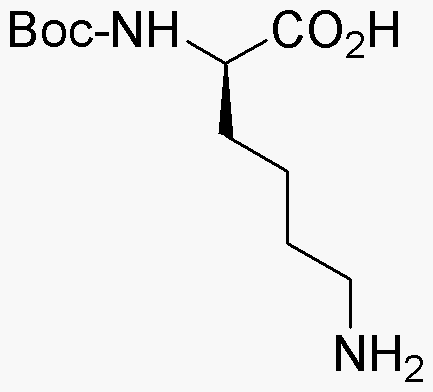Na-Boc-D-lysine is widely utilized in research focused on
- Peptide Synthesis: This compound serves as a key building block in the synthesis of peptides, particularly in the pharmaceutical industry, where it helps create biologically active compounds.
- Drug Development: Its use in drug formulation allows researchers to modify the properties of active pharmaceutical ingredients, enhancing their stability and bioavailability.
- Bioconjugation: Na-Boc-D-lysine is employed in bioconjugation processes, linking biomolecules for targeted drug delivery systems, which is crucial in cancer therapy.
- Research in Neuroscience: This compound is utilized in studies related to neurotransmitter function, aiding in the development of treatments for neurological disorders.
- Protein Engineering: It plays a significant role in protein engineering, allowing scientists to introduce specific modifications that can improve protein function and stability.
General Information
Properties
Safety and Regulations
Applications
Na-Boc-D-lysine is widely utilized in research focused on
- Peptide Synthesis: This compound serves as a key building block in the synthesis of peptides, particularly in the pharmaceutical industry, where it helps create biologically active compounds.
- Drug Development: Its use in drug formulation allows researchers to modify the properties of active pharmaceutical ingredients, enhancing their stability and bioavailability.
- Bioconjugation: Na-Boc-D-lysine is employed in bioconjugation processes, linking biomolecules for targeted drug delivery systems, which is crucial in cancer therapy.
- Research in Neuroscience: This compound is utilized in studies related to neurotransmitter function, aiding in the development of treatments for neurological disorders.
- Protein Engineering: It plays a significant role in protein engineering, allowing scientists to introduce specific modifications that can improve protein function and stability.
Documents
Safety Data Sheets (SDS)
The SDS provides comprehensive safety information on handling, storage, and disposal of the product.
Product Specification (PS)
The PS provides a comprehensive breakdown of the product’s properties, including chemical composition, physical state, purity, and storage requirements. It also details acceptable quality ranges and the product's intended applications.
Certificates of Analysis (COA)
Search for Certificates of Analysis (COA) by entering the products Lot Number. Lot and Batch Numbers can be found on a product’s label following the words ‘Lot’ or ‘Batch’.
*Catalog Number
*Lot Number
Certificates Of Origin (COO)
This COO confirms the country where the product was manufactured, and also details the materials and components used in it and whether it is derived from natural, synthetic, or other specific sources. This certificate may be required for customs, trade, and regulatory compliance.
*Catalog Number
*Lot Number
Safety Data Sheets (SDS)
The SDS provides comprehensive safety information on handling, storage, and disposal of the product.
DownloadProduct Specification (PS)
The PS provides a comprehensive breakdown of the product’s properties, including chemical composition, physical state, purity, and storage requirements. It also details acceptable quality ranges and the product's intended applications.
DownloadCertificates of Analysis (COA)
Search for Certificates of Analysis (COA) by entering the products Lot Number. Lot and Batch Numbers can be found on a product’s label following the words ‘Lot’ or ‘Batch’.
*Catalog Number
*Lot Number
Certificates Of Origin (COO)
This COO confirms the country where the product was manufactured, and also details the materials and components used in it and whether it is derived from natural, synthetic, or other specific sources. This certificate may be required for customs, trade, and regulatory compliance.


